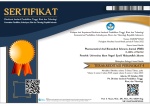Efektivitas Ekstrak Daun Pepaya (Carica papaya L.) sebagai Wound Healing Menggunakan Ikan Zebra Danio rerio Hamilton, 1822 Yang Diinduksi Hiperglikemia sebagai Model
Abstract
Papaya leaves are known to have antidiabetic and wound-healing activities because they contain flavonoids, alkaloids, tannins, and saponins. Tests of the activity of papaya leaf extract in mouse models have been widely conducted. In this study, the wound healing activity of papaya leaves was carried out using zebrafish as a model, because of their ability to regenerate and 70% similarity to human glucose metabolism. This study aimed to analyze the potential of zebrafish as a model for healing diabetic wounds using 96% ethanol extract from papaya leaves. Zebrafish were divided into six groups, namely normal control, negative control, positive, and papaya leaf extract 125, 187.5, and 250 ppm. The parameters observed were a decrease in blood sugar levels, regeneration of the zebrafish caudal fin, and survival rate of the fish. The results showed that there was an effect of administering papaya leaf extract at doses of 125, 187.5, and 250 ppm respectively to reduce blood sugar levels by an average of 42.67; 44.33; and 72 mg/dL, an increase in fin length of 1; 1.3; 1 mm, and survival rate with a percentage of 91%, 91%, 64%. It was concluded that zebrafish could be used as a test model for diabetic wound healing. Apart from that, the use of 96% ethanol extract from papaya leaves affects the healing of diabetic wounds. Of the 3 doses given with 96% ethanol extract of papaya leaves, the best dose for healing diabetic wounds was 187.5 ppm.
Keywords
References
Darniwa, A. V., Cahyanto, T., & Hidayah, S. N. (2021). Effect of Mango Leaf Shoot Extract (Mangifera indica L.) on Zebra Fish (Danio rerio) Cell Regeneration Induced by Hyperglycemia. Jurnal Ilmu Hayat, 5(2). http://journal2.um.ac.id/index.php/jih/index
Effendi, M. (1997). Biologi Perikanan. Penerbit Yayasan Pustaka Nusantara.
Farmakope Herbal Indonesia. (2017). Farmakope Herbal Indonesia (Edisi II).
Fauziah, L., & Wakidah, M. (2019). Extraction of Papaya Leaves (Carica papaya L.) Using Ultrasonic Cleaner. EKSAKTA: Journal of Sciences and Data Analysis, 35–45. https://doi.org/10.20885/eksakta.vol19.iss1.art4
Gede Wiranata, I., & Malida, M. V. S. (2022). Pengaruh Pelarut Dan Metode Ekstraksi Terhadap Kandungan Metabolit Sekunder Dan Nilai Ic50 Ekstrak Umbi Bit (Beta vulgaris L.) Effect Of Solvent And Extraction Method On Secondary Metabolites And Ic50 Of Beetroot Extract (Beta vulgaris L.). In Jurnal Integrasi Obat Tradisional • (Vol. 2, Issue 1). https://usadha.unmas.ac.id
Hardianti, M., Yuniarto, A., & Hasimun, P. (2021). Review: Zebrafish (Danio Rerio) Sebagai Model Obesitas dan Diabetes Melitus Tipe 2. Jurnal Sains Farmasi & Klinis, 8(2), 69. https://doi.org/10.25077/jsfk.8.2.69-79.2021
Hayati, F., Putri, C. A., Awaluddin, R., Maizulfiani, A., & Dwi Dharma, D. (2017). Pengembangan Metode Uji Antihiperglikemia Dengan Zebrafish. Menuju Masyarakat Madani Dan Lestari.
IACUC. (2021). IACUC Policy 23: Use of Zebrafish for Research and Teaching. https://oacu.oir.nih.gov/sites/default/files/uploads/arac-guidelines/zebrafish.pdf.
Indriyanti, N. (2020). Zebrafish (Danio rerio) Sebagai Model Hewan Coba pada Pengujian Aktivitas Obat. Proceeding of Mulawarman Pharmaceuticals Conferences, 11, 80–83.
Istriningsih, E., & Solikhati, D. I. K. (2021). Aktivitas antidiabetik ekstrak rimpang kunyit (Curcuma domestica Val.) pada Zebrafish (Danio rerio). Parapemikir: Jurnal Ilmiah Farmasi, 10(1), 60–65.
Jörgens, K., H. J. L. , H. H. P. , & K. J. (2012). 22402952. Zebrafish: A Model for Understanding Diabetic Complications. , 120(4), 186–187.
Karim, S. F. (2022). Formulasi Dan Uji Aktivitas Gel Antiinflamasi Ekstrak Etanol Daun Pepaya (Carica PAPAYA L.) Pada Mencit Jantan Putih (Mus MUSCULUS). Jurnal Ilmiah Farmasi Farmasyifa, 5(2), 112–121. HTTPS://DOI.ORG/10.29313/JIFF.V5I2.8970
Karimatulhajj, H., Yuni Elfasyari, T., Arviana Ihsan, E., Adiyas Putra, T., Hariadi, P., & Ariani, C. (2017). Effect of Diabetes Condition on Topical Treatment of Binahong Leaf Fraction in Wound Healing Process Pengaruh Kondisi Diabetes pada Pemberian Topikal Fraksi Daun Binahong dalam Proses Penyembuhan Luka. Traditional Medicine Journal, 22(2).
Khotimah, H., Wari, F. E., Noviasari, D., Octaviana, A., Supriadi, R. F., Norisa, N., Permata, T. R., Diestika, Y., Ali, M. M., & Kalsum, U. (2020). Centella asiatica alleviates neurotoxicity and development of lead-exposed zebrafish larvae. Aquaculture, Aquarium, Conservation & Legislation, 13(4), 1886–1898.
Lin, B., Ma, J., Fang, Y., Lei, P., Wang, L., Qu, L., Wu, W., Jin, L., & Sun, D. (2023). Advances in Zebrafish for Diabetes Mellitus with Wound Model. Bioengineering, 10(3), 330. https://doi.org/10.3390/bioengineering10030330
Meherunisa, Jaiswal, S., & Seth, V. (2018). Study of Metformin Effect on Antimicrobial Property. International Archives of BioMedical And Clinical Research, 4. https://doi.org/10.21276/iabcr.2018.4.3.00
Muchdar, F., Juharni, J., & Andriani, R. (2020). Utilization of Different Probiotics on Growth and Survival Rate of Blacktail Zebra fish (Dascyllus melanurus). Agrikan: Jurnal Agribisnis Perikanan, 13(2), 222–231. https://doi.org/10.29239/j.agrikan.13.2.222-231
Naomi, R., Bahari, H., Yazid, M. D., Embong, H., & Othman, F. (2021). Zebrafish as a model system to study the mechanism of cutaneous wound healing and drug discovery: Advantages and challenges. In Pharmaceuticals (Vol. 14, Issue 10). MDPI. https://doi.org/10.3390/ph14101058
Nayak, S., & Maureen Pinto Pereira, L. (2007). Wound healing activity of Carica papaya L. In experimentally induced diabetic rats Evaluation of vitamin D relationship with type 2 diabetes and systolic blood pressure View project Diabetes in primary care View project. In Article in Indian Journal of Experimental Biology.https://www.researchgate.net/publication/5966189
Niza, S., Khumala, I. P., Advina Herdiyani, D., & Pramuningtyas, R. (2020). Efektivitas Ekstrak Daun Pepaya (Carica Papaya) Terhadap Luka Bakar Terinfeksi The Efficacy Of Papaya Leaf (Carica Papaya) Extract On Infected Wound Burn.
Oliver, T. I., & Mutluoglu, M. (2022). Diabetic Foot Ulcer. StatPearls Publishing, Treasure Island (FL). http://europepmc.org/books/NBK537328
Putu, N., Sari, R., Bodhi, W., & Lebang, J. S. (2021). Anti-Inflammatory Activity Test Of Ethanol Extract Of Papaya Leaf (Carica Papaya L.) In White Male Rats (Rattus Norvegicus) Uji Efek Antiinflamasi Ekstrak Etanol Daun Pepaya (Carica Papaya L.) Pada Tikus Putih Jantan (Rattus norvegicus).
Ramadhian, M. R., & Widiastini, A. A. (2018). Kegunaan Ekstrak Daun Pepaya (Carica papaya) Pada Luka. J Agromedicine |, 5, 513.
Santoso, S. (2020). Panduan Lengkap SPSS 26. Elex Media Komputindo.
DOI: 10.15408/pbsj.v6i1.38957
Refbacks
- There are currently no refbacks.






